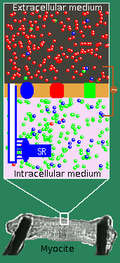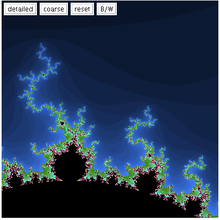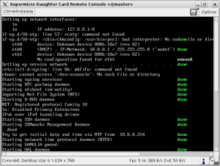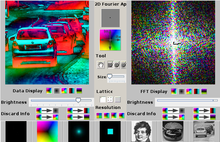Java applet








A Java applet is an applet delivered to the users in the form of Java bytecode. Java applets can run in a Web browser using a Java Virtual Machine (JVM), or in Sun's AppletViewer, a stand-alone tool for testing applets. Java applets were introduced in the first version of the Java language in 1995. Java applets are usually written in the Java programming language but they can also be written in other languages that compile to Java bytecode such as Jython,[8] JRuby,[9] or Eiffel (via SmartEiffel).[10]
Java applets run at a speed that is comparable to (but generally slower than) other compiled languages such as C++, but many times faster than JavaScript.[11] In addition they can use 3D hardware acceleration that is available from Java. This makes applets well suited for non trivial, computation intensive visualizations.
Since Java's bytecode is platform independent, Java applets can be executed by browsers for many platforms, including Microsoft Windows, Unix, Mac OS and Linux. It is also trivial to run a Java applet as an application with very little extra code. This has the advantage of running a Java applet in offline mode without the need for any Internet browser software and also directly from the development IDE.
Technical information
Java applets are executed in a sandbox by most web browsers, preventing them from accessing local data like clipboard or file system. The code of the applet is downloaded from a web server and the browser either embeds the applet into a web page or opens a new window showing the applet's user interface.
A Java applet extends the class java.applet.Applet, or in the case of a Swing applet, javax.swing.JApplet. The class must override methods from the applet class to set up a user interface inside itself (Applet is a descendant of Panel which is a descendant of Container. As applet inherits from container, it has largely the same user interface possibilities as an ordinary Java application, including regions with user specific visualization.
The first implementations involved downloading an applet class by class. While classes are small files, there are frequently a lot of them, so applets got a reputation as slow loading components. However, since jars were introduced, an applet is usually delivered as a single file that has a size of the bigger image (hundreds of kilobytes to several megabytes).
The domain from where the applet executable has been downloaded is the only domain to which the usual (unsigned) applet is allowed to communicate. This domain can be different from the domain where the surrounding HTML document is hosted.
Java system libraries and runtimes are backwards compatible, allowing to write code that runs both on current and on future versions of the Java virtual machine.
Similar technologies
Many Java developers, blogs and magazines are recommending that the Java Web Start technology be used in place of Applets.[12][13]
A Java Servlet is sometimes informally compared to be "like" a server-side applet, but it is different in its language, functions, and in each of the characteristics described here about applets.
Embedding into web page
The applet can be displayed on the web page by making use of the deprecated applet HTML element,[14] or the recommended object element.[15] A non standard embed element can be used[16] with Mozilla family browsers. This specifies the applet's source and location. Object and embed tags can also download and install Java virtual machine (if required) or at least lead to the plugin page. Applet and object tags also support loading of the serialized applets that start in some particular (rather than initial) state. Tags also specify the message that shows up in place of the applet if the browser cannot run it due any reason.
However, despite object being officially a recommended tag, as of 2010, the support of the object tag was not yet consistent among browsers and Sun kept recommending the older applet tag for deploying in multibrowser environments,[16] as it remained the only tag consistently supported by the most popular browsers. To support multiple browsers, the object tag currently requires JavaScript (that recognizes the browser and adjusts the tag), usage of additional browser-specific tags or delivering adapted output from the server side. Deprecating applet tag has been criticised.[17] Oracle now provides a maintained JavaScript code [18] to launch applets with cross platform workarounds.
Example
The following example is made simple enough to illustrate the essential use of Java applets through its java.applet package. It also uses classes from the Java Abstract Window Toolkit (AWT) for producing actual output (in this case, the "Hello, world!" message).
import java.applet.Applet;
import java.awt.*;
// Applet code for the "Hello, world!" example.
// This should be saved in a file named as "HelloWorld.java".
public class HelloWorld extends Applet {
// This method is mandatory, but can be empty (i.e., have no actual code).
public void init() { }
// This method is mandatory, but can be empty.(i.e.,have no actual code).
public void stop() { }
// Print a message on the screen (x=20, y=10).
public void paint(Graphics g) {
g.drawString("Hello, world!", 20,10);
// Draws a circle on the screen (x=40, y=30).
g.drawArc(40,30,20,20,0,360);
}
}
Additional simple applets are available at Wikiversity.<ref>[http://en.wikiversity.org/wiki/Java_applets Java applet section in Wikiversity]</ref>
For [[compiler|compilation]], this code is saved on a plain-[[ASCII]] file with the same name as the class and <tt>.java</tt> extension, i.e. <tt>HelloWorld.java</tt>. The resulting <tt>HelloWorld.class</tt> applet should be placed on the web server and is invoked within an [[HTML]] page by using an <tt><APPLET></tt> or an <tt><OBJECT></tt> tag. For example:
<source lang="html4strict">
<!DOCTYPE HTML PUBLIC
"-//W3C//DTD HTML 4.01 Transitional//EN" "http://www.w3.org/TR/html4/loose.dtd">
<HTML>
<HEAD>
<TITLE>HelloWorld_example.html</TITLE>
</HEAD>
<BODY>
<H1>A Java applet example</H1>
<P>Here it is: <APPLET code="HelloWorld.class" WIDTH="200" HEIGHT="40">
This is where HelloWorld.class runs.</APPLET></P>
</BODY>
</HTML>
Displaying the HelloWorld_example.html page from a Web server, the result should look as this:
A Java applet example
Here it is: Hello, world!
To minimize download time, applets are usually delivered in a form of compressed zip archive (having jar extension). If all needed classes (only one in our case) are placed in compressed archive example.jar, the embedding code would look differently:
<P>Here it is: <APPLET code="HelloWorld" WIDTH="200" HEIGHT="40" ARCHIVE="example.jar">
This is where HelloWorld.class runs.</APPLET></P>
Applet inclusion is described in detail in Sun's official page about the APPLET tag.[19]
Advantages
A Java applet can have any or all of the following advantages[20]:
- It is simple to make it work on Linux, Microsoft Windows and Mac OS X i.e. to make it cross platform. Applets are supported by most web browsers.
- The same applet can work on "all" installed versions of Java at the same time, rather than just the latest plug-in version only. However, if an applet requires a later version of the Java Runtime Environment (JRE) the client will be forced to wait during the large download.
- Most web browsers cache applets, so will be quick to load when returning to a web page. Applets also improve with use: after a first applet is run, the JVM is already running and starts quickly (the JVM will need to restart each time the browser starts afresh).
- It can move the work from the server to the client, making a web solution more scalable with the number of users/clients.
- If a standalone program (like Google Earth) talks to a web server, that server normally needs to support all previous versions in case a user has not kept his or her client software up to date. In contrast, a properly configured browser loads (and caches) the latest applet version, so there is no need to support legacy versions.
- The applet naturally supports the changing user state, such as figure positions on the chessboard.
- Developers can develop and debug an applet direct simply by creating a main routine (either in the applet's class or in a separate class) and calling init() and start() on the applet, thus allowing for development in their favorite Java SE development environment. All one has to do after that is re-test the applet in the AppletViewer program or a web browser to ensure it conforms to security restrictions.
- An untrusted applet has no access to the local machine and can only access the server it came from. This makes such an applet much safer to run than a standalone executable that it could replace. However, a signed applet can have full access to the machine it is running on if the user agrees.
- Java applets are fast - and can even have similar performance to native installed software.
Disadvantages
A Java applet may have any of the following disadvantages:
- It requires the Java plug-in.
- Some organizations only allow software installed by the administrators. As a result, some users can only view applets that are important enough to justify contacting the administrator to request installation of the Java plug-in.
- As with any client-side scripting, security restrictions may make it difficult or even impossible for an untrusted applet to achieve the desired goals.
- Some applets require a specific JRE. This is discouraged.[21]
- If an applet requires a newer JRE than available on the system, or a specific JRE, the user running it the first time will need to wait for the large JRE download to complete.
- Java automatic installation or update may fail if a proxy server is used to access the web. This makes applets with specific requirements impossible to run unless Java is manually updated. The Java automatic updater that is part of a Java installation also may be complex to configure if it must work through a proxy.
- Unlike the older
applettag, theobjecttag needs workarounds to write a cross-browser HTML document.
Compatibility related lawsuits
Sun has made a considerable effort to ensure compatibility is maintained between Java versions as they evolve, enforcing Java portability by law if required. Oracle seems to be continuing the same strategy.
1997 Sun – Microsoft lawsuit
The 1997 lawsuit [22] was filed after Microsoft modified its own Java Virtual Machine which shipped with Internet Explorer. Microsoft added about 50 methods and 50 fields[22] into the classes within the java.awt, java.lang, and java.io packages. Other modifications included removal of RMI capability and replacement of Java native interface from JNI to RNI, a different standard. RMI was removed because it only easily supports Java to Java communications and competes with Microsoft DCOM technology. Applets that relied on these changes or just inadvertently used them worked only within Microsoft's Java system. Sun sued for breach of trademark, as the point of Java was that there should be no proprietary extensions and that code should work everywhere. Microsoft agreed to pay Sun $20 million, and Sun agreed to grant Microsoft limited license to use Java without modifications only and for a limited time.[23]
2002 Sun – Microsoft lawsuit
Microsoft continued to ship its own unmodified Java virtual machine. Over years it has become extremely outdated yet still default for Internet Explorer. In 2002 Sun filed an antitrust lawsuit, claiming that Microsoft's attempts at illegal monopolization have harmed the Java platform. Sun demanded Microsoft distribute Sun's current, binary implementation of Java technology as part of Windows, distribute it as a recommended update for older Microsoft desktop operating systems and stop the distribution of Microsoft's Virtual Machine (as its licensing time, agreed in the previous lawsuit, had expired).[23] Microsoft paid $700 million for pending antitrust issues, another $900 million for patent issues and a $350 million royalty fee to use Sun's software in the future.[24][25]
2010 Oracle – Google lawsuit
Google has developed their own Android platform that uses Java features and concepts yet is not compatible with standard libraries. This may be a violation of conditions under which Sun granted OpenJDK patents to use open source Java for all.[26] In 2010, Oracle sued Google[27] for using Java "in a wrong way", claiming that "Google's Android competes with Oracle America's Java" and that "Google has been aware of Sun’s patent portfolio ... since Google hired certain former Sun Java engineers". Oracle currently seems claiming[vague] as much as to stop the further Android development, trying to replace it by standard Java version.[28] This lawsuit is currently ongoing.
Security
There are two applet types with very different security models: signed applets and unsigned applets.[29]
Unsigned
Limitations for the unsigned applets are understood as "draconian":[30] they have no access to the local filesystem and web access limited to the applet download site; there are also many other important restrictions. For instance, they cannot access system properties, use their own class loader, call native code, execute external commands on a local system or redefine classes belonging to core packages included as part of a Java release. While they can run in a standalone frame, such frame contains a header, indicating that this is an untrusted applet. Successful initial call of the forbidden method does not automatically create a security hole as an access controller checks the entire stack of the calling code to be sure the call is not coming from an improper location.
As with any complex system, multiple security problems have been discovered and fixed since Java was first released. Some of these (like the Calendar serialization security bug[31]) persisted for many years without anybody being aware. However it seems that most (if not all) security holes are closed before anybody being able to exploit them in a larger scale.
Some studies mention applets crashing the browser or overusing CPU resources but these are classified as nuisances[32] and not as true security flaws. However, unsigned applets may be involved in combined attacks that exploit a combination of multiple severe configuration errors in other parts of the system.[33] An unsigned applet can also be more dangerous to run directly on the server where it is hosted because while code base allows it to talk with the server, running inside it can bypass the firewall. An applet may also try DoS attacks on the server where it is hosted but usually people who manage the web site also manage the applet, making this unreasonable. Communities may solve this problem via source code review or running applets on a dedicated domain.[34][35]
The unsigned applet can also try to download malware hosted on originating server. However it could only store such file into temporary folder (as its transient data) and has no means to complete the attack by executing it. There were attempts to use applets for spreading Phoenix and Siberia exploits this way[citation needed], while these exploits do not use Java internally and were also distributed in a number of other ways.
As of 1999 no real security breaches involving unsigned applets have ever been publicly reported.[32][36] Using an up-to-date Web browser is usually enough to be safe against the known direct attacks from unsigned applets.
Signed
A signed applet[37] contains a signature that the browser should verify through a remotely running, independent certificate authority server. Producing this signature involves specialized tools and interaction with the authority server maintainers. Once the signature is verified, and the user of the current machine also approves, a signed applet can get more rights, becoming equivalent to an ordinary standalone program. The rationale is that the author of the applet is now known and will be responsible for any deliberate damage.[vague] This approach allows applets to be used for many tasks that are otherwise not possible by client-side scripting. However, this approach requires more responsibility from the user, deciding whom he or she trusts. The related concerns include a non-responsive authority server, wrong evaluation of the signer identity when issuing certificates, and known applet publishers still doing something that the user would not approve of. Hence signed applets that appeared from Java 1.1 may actually have more security concerns.[38]
Self signed
Self-signed applets, which are applets signed by the developer themselves, may potentially pose a security risk; java plugins provide a warning when requesting authorisation for a self-signed applet, as the function and safety of the applet is guaranteed only by the developer itself, and has not been independently confirmed. Such self-signed certificates are usually only used during development prior to release where third-party confirmation of security is unimportant, but most applet developers will seek third-party signing to ensure that users trust the applet's safety.
Java security problems are not fundamentally different from similar problems of any client-side scripting platform. In particular, all issues related to signed applets also apply to Microsoft ActiveX components.
Alternatives
Alternative technologies exist (for example, JavaScript, Curl, Flash, and Microsoft Silverlight) that satisfy some of the scope of what is possible with an applet. Of these, JavaScript is not always viewed as a competing replacement; JavaScript can coexist with applets in the same page, assist in launching applets (for instance, in a separate frame or providing platform workarounds) and later be called from the applet code.[39] JavaFX that is an extension of Java platform may also be viewed as an alternative.
See also
References
- ^ World of Fungi - page of the scientific project, serving an applet that is used as an illustration figure
- ^ The home site of the 3D protein viewer (Openastexviewer) under LGPL
- ^ The virtual hearth
- ^ The home site of the Mandelbrot set applet under GPL
- ^ The home site of the chess applet under BSD
- ^ Java.Sun.com
- ^ 2D FFT Java applet
- ^ Jython applet page
- ^ About Java applets in Ruby
- ^ At tool to produce Java applets with SmartEiffel
- ^ An example of the 2005 year performance benchmarking
- ^ JavaWorld.com
- ^ JavaChannel.net
- ^ W3.org
- ^ W3.org
- ^ a b Sun's position on applet and object tags
- ^ Criticism of APPLET tag deprecation
- ^ Java applet launcher from Oracle
- ^ Java.Sun.com Sun's APPLET tag page
- ^ Oracle official overview on Java applet technology
- ^ Oracle notes on Java versioning
- ^ a b 1997 year Sun-Microsoft lawsuit in JavaWorld
- ^ a b Sun's page, devoted for the lawsuits against Microsoft
- ^ Sun - Microsoft 2002 lawsuit
- ^ Microsoft page devoted to the Sun - Microsoft 2002 lawsuit
- ^ [1]
- ^ Oracle sues Google over Android
- ^ Discussions on Oracle plans in mashable.com
- ^ Sun's explanation about applet security
- ^ Java Security FAQ Applet Security Restrictions by Mark Wutka
- ^ Description of Calendar serialization security bug
- ^ a b Java Security FAQ
- ^ Avirubin.com
- ^ Strategy.Wikimedia.org, proposal with discussion about Java applets in community sites
- ^ Ultrastudio.org, user editable educational site with full applet support
- ^ ~ G.McGraw, E.W. Felten. Securing Java. ISBN 047131952X
- ^ Informit.com
- ^ Sid Stamm, Markus Jakobsson, Mona Gandhi (2006). A study in socially transmitted malware
- ^ Rgagnon.com, calling a Java applet from JavaScript
External links
- Latest version of Sun Microsystems Java Virtual Machine (includes browser plug-ins for running Java applets in most web browsers).
- Information about writing applets from Sun Microsystems
- Demonstration applets from Sun Microsystems (JDK 1.4 - include source code)
- JavaRanch Applet FAQ
- Pulpcore: Open-source 2D rendering and animation framework for the Java plug-in

